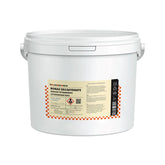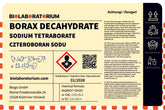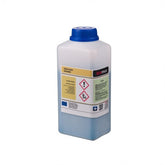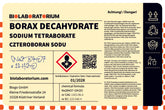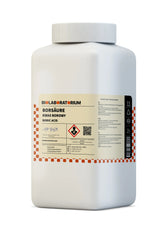Strontium nitrate – An inorganic compound with special properties and analytical applications
Strontium nitrate, also known as strontium(II) nitrate or Sr(NO₃)₂, is an inorganic compound that is significant in various areas of science and industry. In this blog post, we will take a closer look at the properties, production, and applications of strontium nitrate.
Properties of Strontium Nitrate
Strontium nitrate is a crystalline, white salt that is well soluble in water. It has a molar mass of 211.63 g/mol and a density of 2.982 g/cm³. The melting point is 570 °C, while the boiling point is 645 °C.
An interesting property of strontium nitrate is its ability to glow when heated. This effect is called strontium nitrate luminescence and occurs when the salt is thermally excited. It emits a characteristic reddish light, which is due to transitions in the electronic states of the strontium ion.
Furthermore, strontium nitrate is an oxidizing agent and can act as an oxidizer in reactions. This property makes it interesting for various chemical applications.
Production of Strontium Nitrate
Strontium nitrate can be produced in several ways. A common method is the reaction of strontium carbonate (SrCO₃) with nitric acid (HNO₃):
SrCO₃ + 2 HNO₃ → Sr(NO₃)₂ + CO₂ + H₂O
Here, the strontium carbonate is dissolved in nitric acid, producing carbon dioxide and water as byproducts. The strontium nitrate then crystallizes out of the solution.
Another possibility is the reaction of strontium oxide (SrO) with dinitrogen pentoxide (N₂O₅):
SrO + 2 N₂O₅ → Sr(NO₃)₂
Here, strontium oxide reacts directly with dinitrogen pentoxide to form strontium nitrate.
The purity and quality of the final product depend on the starting materials used and the reaction conditions. For many applications, high purity of strontium nitrate is required.
Analytical Applications of Strontium Nitrate
Strontium nitrate is used in various analytical methods. For one, it can be used as a reagent in atomic absorption spectroscopy (AAS) to determine strontium in samples. This utilizes the characteristic absorption of strontium atoms at specific wavelengths.
Additionally, strontium nitrate can be used in X-ray fluorescence analysis (XRF) as a matrix modifier. Here it serves to influence the excitation and emission of X-ray radiation by the sample, thereby improving the quantification of elements.
In ion chromatography, strontium nitrate can be used as an eluent to separate and analyze cations such as strontium, calcium, or magnesium. The different retention times of the ions allow their identification and quantification.
Furthermore, strontium nitrate is used in mass spectrometry. Here it can be used as an ionization reagent to analyze strontium isotopes and determine their ratios.
Further Applications of Strontium Nitrate
In addition to analytical applications, strontium nitrate has other uses:
Pyrotechnics
Strontium nitrate is used in pyrotechnics as an oxidizing agent to produce red fireworks and signal flares. This utilizes the salt's ability to glow when heated.
Ceramics and Glass
In the ceramics and glass industry, strontium nitrate can be used as an additive to improve the optical properties, hardness, and resistance of materials.
Medical Applications
Strontium nitrate is also used in medicine, for example in the treatment of osteoporosis. Strontium ions can be incorporated into bones and increase bone density.
Agriculture
In agriculture, strontium nitrate is occasionally used as a fertilizer, as strontium ions can be beneficial for plant growth.
Conclusion
Strontium nitrate is a versatile inorganic compound with special properties that are significant in various fields of science and industry. From analytics to pyrotechnics and medical applications, strontium nitrate offers a wide range of uses. Due to its ability to glow when heated, as well as its oxidation properties, it has established itself as a useful salt.

